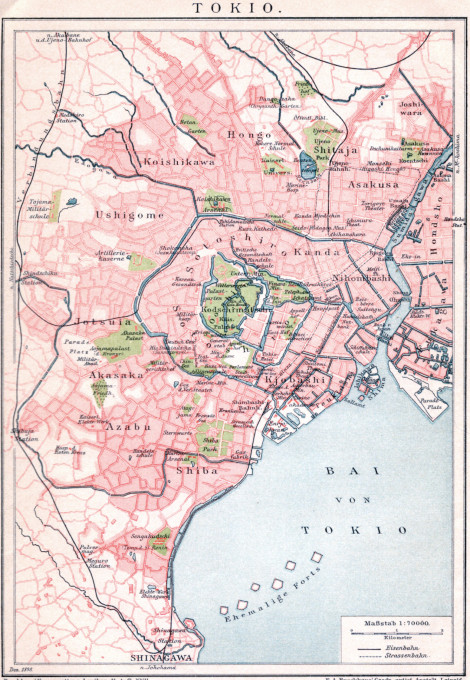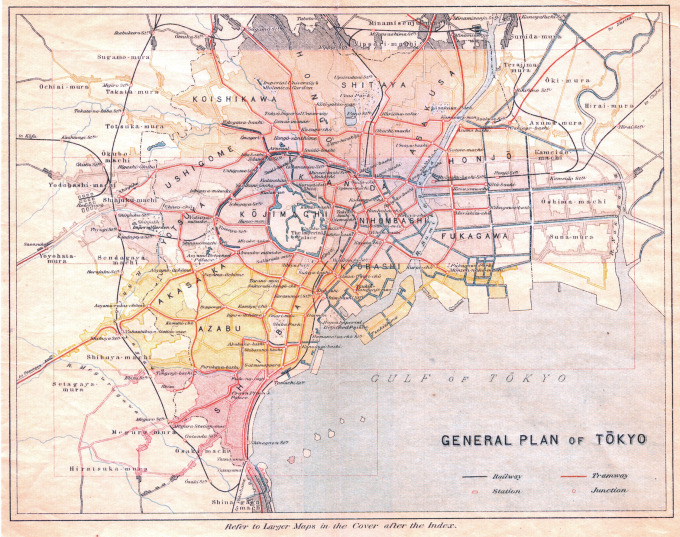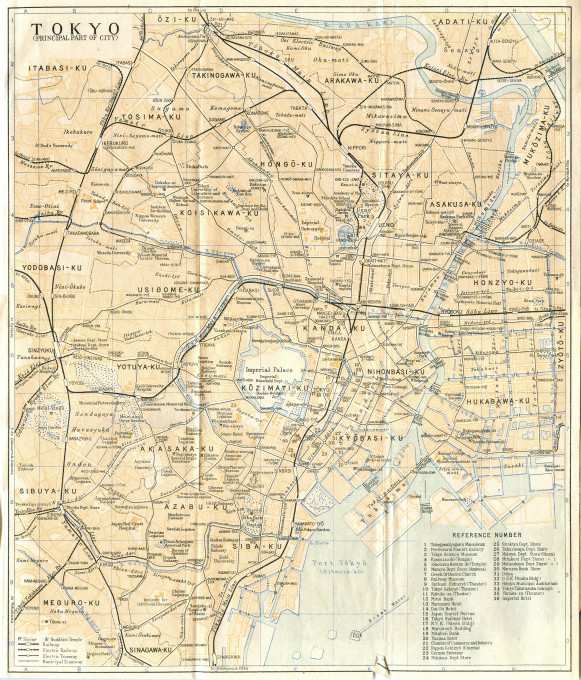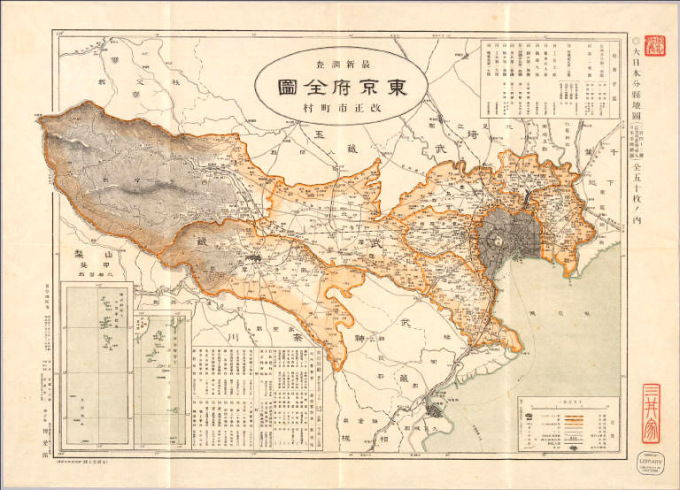The charm of Tokyo to the visitor is the huge experiment it
presents in the meeting of East and West.
The air is electric with change and new ideas.
– Zoe Kincaid, “Tokyo Vignettes” (1933) –
See also:
Tokyo City Hall, c. 1910-1930
The overthrow of the Tokugawa Shogunate and the restoration of Imperial rule in 1868 led to the rapid modernization and Westernization of Japan. Edo had been the administrative center of the Shogun [general of the armies]; renamed Tokyo [east capital] by the young Emperor Meiji, who relocated from Kyoto to Edo after the Restoration, the city would from here-on serve as Japan’s new national, and imperial, capital. The revolution that ended a 250-year old status quo signaled an end to Japan’s self-imposed isolation as a feudal backwater and the beginning of its unprecedented, rapid transformation into an industrial, political, and cultural world power.
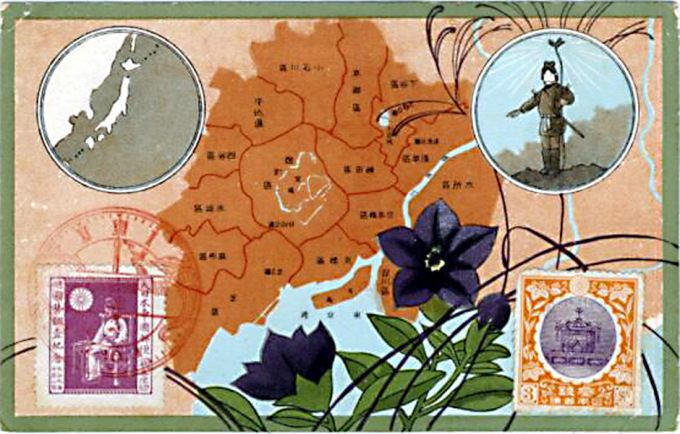
Commemorative postcard, c. 1918, depicting the original 15 “ku” (wards) establishing Tokyo City in 1878 – with the Imperial Palace at center.
In Japan’s headlong rush toward modernization, Tokyo led the metamorphosis the whole of the nation underwent within only a few decades. For the foreign expatriate, the city represented a modern landscape of trading opportunities and exploitation. For the typical Tokyo-ite, and any out-country Japanese visiting the new capital, it was metropolis wonderland of many marvelous and wonderful new creations and adapted ideas.
Tokyo was a city of over a million during the latter Tokugawa period. There was initially a decline in the population of the new capital due primarily to daimyo [provincial lords] no longer being required to keep family members and retainers in the capital as virtual hostages of the Shogun. An 1877 census, the first taken by the Meiji government, found Tokyo’s population to be only 583,300 persons. That number more than doubled within a decade. By 1941, on the eve of the Pacific War, the population had grown to more than 6 million people, making it the third most populated city in the world.
When first organized in 1869 Tokyo City comprised 15 ku [ward, similar to a New York City borough]: Fukugawa, Honjo, Asakusa, Sotoshiro, Kanda, Nihonbashi, Kyobashi, Shitaya, Hongo, Koishikawa, Ushigome, Yotsuya, Akasaka, Azabu, and Shiba. The feudal han [domain] system was abolished in 1878 with the establishment of Tokyo Prefecture [Tokyo-ken], comprised of Tokyo City and five suburban districts. In 1893 Tokyo-ken was expanded to include four new counties [gun] west of the city including the three Tama Districts.
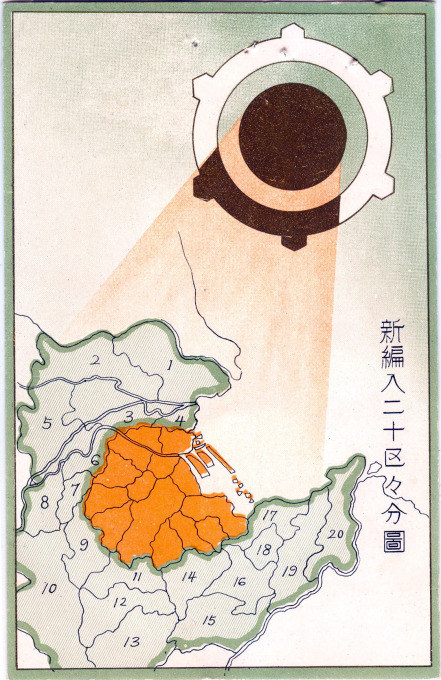
Postcard commemorating the incorporation of 20 additional “wards” into Greater Tokyo, c. 1932, including Shinjuku and Shibuya.
In 1932, the metropolitan Greater Tokyo was established with the incorporation of 82 additional rural and suburban towns and villages, including the old suburban post towns of Shinagawa, Shinjuku, Shibuya and Meguro, into the original Tokyo-ken. The ku within the city-proper also increased then from 15 to 35. Greater Tokyo, in 1943, was reconstituted into the now-familiar Tokyo-to [Tokyo metropolis] with the formal political merger of Tokyo City into Tokyo Prefecture, at which time the number of city wards was reduced to the current 23 ku. Present-day Tokyo-to is made up of 23 wards, 26 cities, and 5 districts/sub-prefectures that stretch west from Tokyo Bay to the foothills of the Japan Alps.
Tokyo today bears little resemblance to the city it was 100 years ago. Fire, earthquakes and war have done little to dampen the city’s spirit but have resulted in great changes to its urban landscape. Now a metropolis of steel and glass skyscrapers (and acres of dour gray ferro-concrete), little remains of the city that welcomed in the 20th century as a young, vibrant capital experimenting with new forms, fusions and shapes of urban architecture amidst a rush of profound social change.


